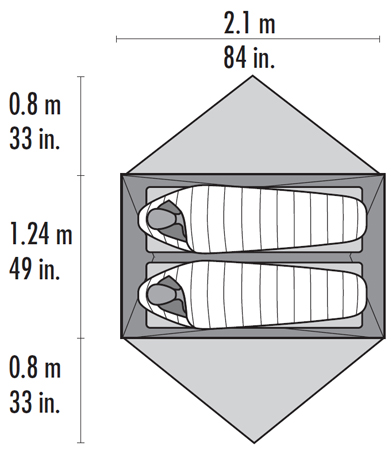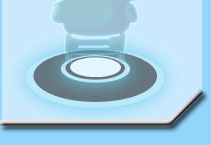Everyone knows about tents. They are the shelters used during camp outs, are normally staked to the ground, and keeps water and bugs out... most of
the time. On a backpacking trip however, selecting the right tent can make all the difference. While you can use your typical base camp tent on a
backpacking trip, base camp tents are made for comfort. With this in mind the usual result for this type of tent is a bulky and heavy one; it also
means you would have to carry the extra weight with you when you go on your trip.
Enter the backpacking tent. A backpacking tent is a modification of a base tent so that the weight of the tent has been reduced as well as the size.
This will allow the tent to be packed into a smaller bag as well as lightening your pack so other important items can be packed. However keep in
mind that the main purpose of the tent is to protect a scout from the elements as well as keep bugs out when sleeping. By reducing the pack size and
the weight of the tent, the overall tent was also made smaller. So while backpacking tents are made durable, they are not all necessarily comfortable.
So the questions comes back to: How do I choose a backpacking tent?
|
Selecting a Backpacking Tent
Similar to a backpacking backpack, a tent should be looked at as an investment. While some scouts prefer sleeping under the stars and, is not
required for most trips, a tent can protect the scouts from the elements just in case mother nature decides to rain or snow on your backpacking
trip. There are many factors when it comes to selecting a tent; however the two primary ones are listed below:
|
Space
As any scout knows, space on the backpacking backpack is very limited. This is especially true on longer excursion trips. Before buying a tent,
the scout should look at the pack size of the tent. A pack size is the size of the tent after it has been packed and stored in their stuff sack.
The larger the pack size the less room for other gears that are needed on the trip.
In addition to the pack size, the scout should also determine how many people will be using the tent. Similar to base camp tents, backpacking tents
can fit four or more people in a tent. In large backpacking groups using a large backpacking tent, scouts would normally break the tents into basic
elements and have each scout in a patrol carry an element. By doing this, the weight of the tent can be spread across all the scouts of the patrol;
however this also means that the risk of losing gear is higher.
There are also tents that fit three people, two people, or even one person tents. One person tents are normally called solo tents and are used by
backpackers who would like to carry their full set of gear or by minimalist who would like to reduce as much weight in their pack as possible. In
addition, by having each scout have their own tent, the scout is independent of other members in their patrol and would always have a tent.
|
Weight
In backpacking, weight is key. The lighter the pack, the easier it is for the scout to go from one location to another; it also allows the scout to
conserve energy. The weight factor coincides with the space factor that was discussed above. The larger the tent, the more comfortable the scout will
be; however you will be exchanging that for more weight. The material of the tent also can affect how heavy the tent can be. The scout should find
the perfect balance between comfort and weight. The table below contains a breakdown of the capacity of the tent vs the weight:
|
Tent Type VS Estimated Weight
| Tent Type |
Estimated Weight |
| 1 Person (Solo) |
Approximately Two pounds |
| 2 Person Tent |
Three to Six pounds |
| 3+ Person |
Six to Ten pounds |
|
As the table above illustrates, the size of the tent greatly affects the weight of the tent; however this is only on average. Given the large
variety of tents available which are made from different materials, there may be a two person tent that is under three pounds or more than six.
Before purchasing the tent, the scout should determine the weight and decide if they are comfortable carrying the load.
|
Additional Factors
In backpacking the primary factors are always weight and space. A scout should attempt to find their own perfect balance of these two factors and
also weigh additional factors such as those listed below:
- Interior Volume and Dimension
- Tent Seasons
- Pockets and Vestibule
- Tent Setup and Material
- Price
|
Interior Volume and Dimension
When determining the volume and dimension of the tent, the scout should look at the floor space and the height of the tent. The height and the floor
space are normally described in inches and meters and would give the scout an idea of how big the tent is when it is set up. The images below shows
the floor space and the height of a tent.
|


|
|
As illustrated in the images above, the tent will have diagrams explaining the height and floor space of a tent. A thing to keep in mind is that
some tents may not be perfectly squared so the scout should keep in mind that the sleeping area may be different from the entire floor plan. Another
item to keep in mind is that the floor space may include the vestibule area. The vestibule is used for gear storage and will be explained more in
the Pockets and Vestibule section.
|
Tent Seasons
When looking for a tent, the scout should determine the weather in which the tent is used in. While this may be a tough call since scouts backpack
through all kinds of weather, but the weather should be factored in to the decision of the tent. A tent developed for extreme weather will be
heavier and more expensive than a tent designed for the summer. To identify tent designs, manufactures will normally state the number of seasons
that can be used with the tent. The breakdown of seasons are listed below:
|
Tent Season Breakdown
| Tent Season |
Usage |
| 4 Season Tents |
Suitable for all-weather backpacking. The tents may be used in snow, rain, and high winds. |
| 3 Season Tents |
Suitable for the weather of spring, summer and fall. May not perform as well in snow due to the drop in temperature and the possible increase load of snow on the tent structure. |
| 2 Season Tent |
Generally used for mild weather conditions where weight has a higher priority than insulation. |
| Minimalist |
Used by minimalist to almost eliminate the weight of a shelter. Minimalist may consider a rain fly as shelter where it only prevents rain and does not provide insulation or protection from wind or insects. |
|
As noted above, manufactures classify tents into four different seasons to allow the consumer to determine which tent is suitable for their needs.
While each advancing season provides additional protection from the elements, the weight of the tent also increases. Most scouts only need 3 Season
Tents where 4 Season Tents are normally used for Mountaineers where high winds and large snowfalls are encountered.
|
Pockets and Vestibules
Another factor that may affect the scout's decision when deciding on a backpacking tent would be the quantity and size of pockets and mainly the
size of the tent's vestibules. A vestibule is a small space or cavity at the entrance of a tent. The tent vestibule serves multiple purposes such
as providing shelter from rain when getting out of the tent, and forming another barrier to prevent insects from going in; however the most common
usage of a vestibule is to store gear.
Since backpacking tents are not known for their space, a scout's backpacking backpack is normally stored within the vestibule area. By storing the
gear in the vestibule area, more room can be obtained within the tent while the scout's gear is still protected from natural elements such as rain.
Another usage that the vestibules may provide is a dry area when backpacking. Backpackers are known to use this area to cook meals. Please be
cautious while doing this by making sure the flame is small and that there is abundant ventilation. A scout should always follow the guidelines of
having a fire away from a tent; however this is an option if there isn't a dry area available for boiling water.
|
Tent Setup and Material
When reviewing a tent, the scout should determine the difficulty of setting up a tent and whether the tent is a freestanding tent or a non
freestanding tent. A tent is freestanding when the tent does not require additional equipment to support the tent aside from the provided tent poles.
Most dome tents are freestanding and are preferred since stakes and guidelines are not required for the tent to be operational. The drawback of a
freestanding tent is the weight and the size of the tent. Since non freestanding tent rely mainly on guidelines and stakes, the tent requires less
poles for structural support which reduces the weight of the tent. The images below illustrates a freestanding tent and a non freestanding tent.
|
 
 
|
|
Aside from tent setup, the scout should also review the material that is used on the tent. The material a tent is designed with can play an important
role in determining the weight of a tent as well as the lifespan of the tent. The main parts of a tent are the poles and the tent fabric. The tent
poles are normally constructed from plastic, fiberglass, or aluminum; however there may be other materials that are used. Most backpacking tents use
aluminum since the material is extremely strong compared to it's weight, whereas base camp tents normally use fiberglass since they cost less
to produce and weight isn't much of a factor in base camping.
The two types of fabrics that are normally used for the body of the tent is nylon and polyester. While nylon is lighter and more resistant to abrasion
than polyester, it does not provide as much water and ultraviolet resistance compared to polyester. As such, manufactures normally manufacture tents
where the rainfly is made with polyester and the actual body of the tent is made with nylon, specifically ripstop nylon. Ripstop nylon is a method of
weaving nylon in a way where if a rip does occur on the tent, the weave of the nylon cloth will prevent the rip from spreading throughout the tent.
On certain occasions, the manufacture may enhance the water resistance of a fabric by impregnating the fabric with silicon to make As always, “silnylon”. While
all manufactures apply a coating to the tent to increase the tent's water resistance, the type of coating should also be taken into consideration
because different coatings provide different protection and can also increase the weight of the tent.
|
Price
Like all backpacking equipment, price is always a factor in the decision. Backpacking tents can range from $50 dollars to $500 dollars. A tent that
is made with the lightest most durable material is almost always the most expensive. There are always exceptions such as close-out sales or
promotional items; however tents can get pretty pricey.
Another way to reduce the weight and price of a tent is to create your own footprint. A footprint is a piece of material that is designed to be set
up under the tent to protect the bottom of the tent from abrasion and moisture. Most tents do not come with a footprint, but can be purchased as
an accessory. A scout is thrifty and by creating their own footprint, a scout can also customize how their footprint is designed as well as allowing
them to choose the type of material that they would like to use.
|

















